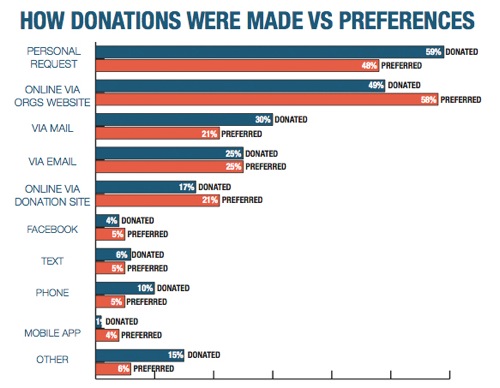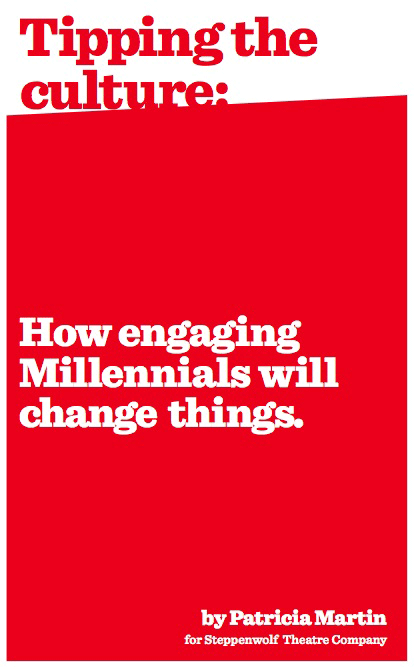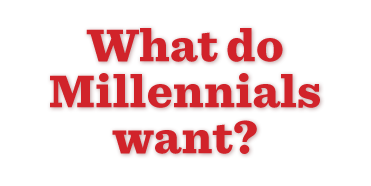Non-profits face many challenges, one of which is intergenerational conflict in the workplace. While a solution will take multiple strategies, professional development is an often cited issue with a simple solution: online learning.
Reflections on the NAMP Conference
Are Subscriptions Dead?
For years we have heard about the decline of subscription sales and revenue across the arts. TCG’s Theatre Facts 2014, for example, showed how “both single ticket and subscription sales were at a 5-year low in 2014.” Subscriptions specifically declined by 6%. However, according to a new study commissioned by the League of American Orchestras and conducted by the Oliver Wyman consulting firm, perhaps the issue is not subscriptions themselves, but the manner in which we have traditionally packaged and sold them.
‘Tis the Season for Getting Those Millennials to Give
With the holidays upon us, Baby Boomers and Generation X'ers selflessly reach deep into their pockets, beyond the lint, to give what they can afford  to not-for-profit organizations. But what about the Millennials? How do we get the generation classified in the media and not-for-profit circles as self-absorbed and self-interested to donate? The Case Foundation presents “Millennial Donors Report 2011,” a survey and summary of the motivations and preferences of the Millennials when it comes to making a donation.
to not-for-profit organizations. But what about the Millennials? How do we get the generation classified in the media and not-for-profit circles as self-absorbed and self-interested to donate? The Case Foundation presents “Millennial Donors Report 2011,” a survey and summary of the motivations and preferences of the Millennials when it comes to making a donation.
Earlier this fall, I posted on the best practices for engaging Millennials, the generation of 20 to 35 year olds that is dramatically affecting the way organizations market their brand and product. So in the true spirit of the holidays, let’s take a look at what may seem like an impossible task: getting the Millennials to donate.
The report surveyed about 3,000 Millennials ranging in age from 20-35 years old. Perhaps the most revealing find of the survey is the following: above all, Millennials value trust. A whopping 90% of Millennial donors surveyed reported they would stop giving to an organization if they had any reason not to trust it. What does this mean for not-for-profits? Build personal relationships with your donors and clearly define where and how the donation is used. Because the Millennials are young professionals, students and young adults with limited funds, they are most concerned their donation of any size will be utilized responsibly. Establishing trust with Millennials will encourage future giving and ensure a long-standing donor-organization relationship.
The report is divided into the categories: giving, giving motivators, special events, communication, volunteering, young professional groups and taking action, as they relate to Millennials. Here is a breakdown of the key findings and the implications for your organization
1. 93% of Millennials gave to not-for-profits in 2010
What this mean for you: Millennials tend to make small donations to multiple organizations, as opposed to the Baby Boomers or Generation X that are loyal to a single organization, gifting large sums of money. They ARE donating, which I am sure comes as a great surprise to the many who tag this generation as plugged-in and tuned-out to the rest of world.
2. An online search using an engine such as Google is the #1 way Millennials get information about a not-for-profit organization
What this means for you: How does your organization appear in a Google search? Millennials often base their decision to donate on the organizations appearance in an online search. Pay attention to your organization’s description on search engines.
3. 57% of Millennial donors gave in response to a personal ask
What this means for you: Though the Millennials seem to inhabit the online space more than their physical space, they are surprisingly more inclined to donate in response to a personal ask. However, that is not reflected in their preferred method of donating- 58% of Millennial donors reported they prefer to make that donation online. An unsuspected dichotomy…
The least preferred methods of the Millennial donors are via mobile applications (4%), the phone (5%) and text message (5%).
Reference the graphic “How donations were made vs preferences” in the report to be sure your organization is providing Millennials with the correct channel for giving that addresses their preferences (the most popular of which are online via your website, email, a donation site, or a personal request). Do not let a Millennial donor slip away by simply neglecting to provide the giving tool that best meets their preferences.
4. 79% of the Millennials surveyed reported having volunteered at least once in 2010
What this means for you: Just as expected of the Millennials, they are strapped for time as young adults and professionals. Thus the resounding reason for not volunteering is lack of time. Millennials are not interested in ongoing volunteer commitments. They prefer one-time, convenient volunteer activities. And obviously, they prefer to volunteer with friends than alone- the ultimate trademark of the Millennials. Of those surveyed, 61% reported they would prefer to volunteer with friends and family as compared to the 44% that indicated they prefer to volunteer on their own.
Get creative with the volunteer opportunities you present to the Millennials. They should be convenient, meaningful, group-friendly and perhaps provide an opportunity for professional development. As we saw when considering how donations are made, Millennials respond favorably to person-to-person contact and requests. Do not hesitate to simply ask Millennials to donate their time. As it turns out, 45% of the respondents reported their reason for not volunteering as never having been asked. So ask away!
5. 85% of Millennial donors are motivated to donate by a compelling and meaningful mission or cause, while only 2% of Millennial donors are motivated by a celebrity endorsement.
What this means for you: We already know Millennials crave meaningful content. They Tweet, re-Tweet and post moving videos, inspiring quotes and stirring news reports. Your website can be a perfect tool for tapping into the Millennials need for meaningful content. Share real-life, specific stories of how a donation supported your cause and not-for-profit. Invite the Millennials to be a part of meetings and discussions regarding the inner-workings of your organization and your strategic plan for the future. Millennials crave meaning, worth and inclusion. Invite them to collaborate with you and they will trust your organization.
The report provides cutting-edge research, insight and practical solutions for attracting and developing relationships Millennial donors. As researchers slowly uncover the hidden truths of these mysterious, influential Millennials and their relationship with the not-for-profit sector, we here at Technology in the Arts will continue to bring you the breaking news!
The Millennial Generation: We’ve got the power
 Commissioned by the Steppenwolf Theatre Company, author and culture analyst Patricia Martin recently published the report “Tipping the culture: How engaging Millennials will change things.”Her extensive research on marketing to the generation “eclipsing Boomers and GenX” boils down to the following: the Millennials, those between the ages of 15 and 31, are more networked than any other generation and thus have the power to influence and determine the success and future of an organization.
Between blogs, Facebook, MySpace, Twitter and smart phone applications, the Millennials are here, there, everywhere, with everyone, and telling you about it. Because of this, if you can catch them and grab their attention, they will market your product for you. But this is not news. The folks here at Technology in the Arts have offered compelling reasons beyond the obvious (marketing advantages) why not-for-profit arts organizations should tap into these viral networks.
Commissioned by the Steppenwolf Theatre Company, author and culture analyst Patricia Martin recently published the report “Tipping the culture: How engaging Millennials will change things.”Her extensive research on marketing to the generation “eclipsing Boomers and GenX” boils down to the following: the Millennials, those between the ages of 15 and 31, are more networked than any other generation and thus have the power to influence and determine the success and future of an organization.
Between blogs, Facebook, MySpace, Twitter and smart phone applications, the Millennials are here, there, everywhere, with everyone, and telling you about it. Because of this, if you can catch them and grab their attention, they will market your product for you. But this is not news. The folks here at Technology in the Arts have offered compelling reasons beyond the obvious (marketing advantages) why not-for-profit arts organizations should tap into these viral networks.
Martin takes a look at the big guys, companies like Google, Ford Motors, and J. Crew, to uncover how they successfully snagged the Millennials. How has J. Crew managed to attract and maintain the 22 to 30 year old Millennials? How did Starbucks gain such a loyal following of 15 to 30 year olds? What techniques are these large, for-profit firms using to advance their brand and secure their position in the future marketplace? Using these case studies, Martin provides insight on marketing to this powerful group of young-adults, divulging what attracts them, how to include them, what they are thinking, what they want and how to engage them.
In her easy-to-digest exposé, Martin sheds light on a generation that seeks to both create and consumer content; a generation that is less interested in sitting passively in the audience than being engaged and having their input heard in the creation of the production. Martin offers the not-for-profit arts sector strategies for effective marketing to Millennials through personalized and engaging social media interactions.
So how do Starbucks and J. Crew do it?
1) Making Millennials the priority, then the brand
2) Increasing the firm’s emotional and lifestyle appeal
3) Creating a sense of belonging for customers through participation
What exactly does this mean to a not-for-profit?
Millennials crave connection, whether through broad networks and communities or through exclusive access to content that creates a sense of intimacy.
Translation: Open your backroom doors by posting video footage to Facebook of a “Day-in-the-life” of your museum director, reveal your “behind-the-scenes” preparations for an upcoming exhibition through Facebook status updates and photo uploads, or tweet from back-stage actors’ excitement moments before the opening act. For those of you theater connoisseurs, break the “fourth wall” to show Millennials you understand their desire for access to content and knowledge. Give Millennials the opportunity, through social media, to discover on their own what you are about. Martin describes this as an “egalitarian social model,” where you (the not-for-profit) and the Millennial become connected as friends and collaborators.
Once you have established a relationship with your users online, your work is only half complete. If you encourage participation online, be sure to reinforce your commitment to the Millennials and their contributions on-site by referencing user generated content in your play-bills, gallery maps, and museum guides.
There is a reason why the Broadway musical Rent and primetime TV shows such as CSI and Gossip Girl have gained momentum among Millennials: they are emotiona lly charged and engage Millennials in meaningful ways. Creating meaning for Millennials in your not-for-profit could begin with a blog. This forum allows for informal discussion, emotional content, and most importantly, participation. Have your blogger pose questions of substance that encourage meaningful and emotional responses in reaction to a performance or exhibit, such as “Do you agree?”, “What do you think?”, “Tell us how you feel” or “Which character did you relate to most?” By giving Millennials the unadulterated freedom to share their perspective and voice in a dynamic forum, they will have a more personalized experience with your organization.
lly charged and engage Millennials in meaningful ways. Creating meaning for Millennials in your not-for-profit could begin with a blog. This forum allows for informal discussion, emotional content, and most importantly, participation. Have your blogger pose questions of substance that encourage meaningful and emotional responses in reaction to a performance or exhibit, such as “Do you agree?”, “What do you think?”, “Tell us how you feel” or “Which character did you relate to most?” By giving Millennials the unadulterated freedom to share their perspective and voice in a dynamic forum, they will have a more personalized experience with your organization.
Fulfilling the emotional desire of Millennials to be connected, heard, and have meaningful experiences will increase the retention rates for this generation in your organization. It does not require the marketing budget or quarterly revenue of J. Crew or Pepsi, just greater attention to the entire customer experience of your cultural brand (think witty videos for downloading, thought-provoking quotes for Millennials to tweet and a survey to remind them they have a stake in your future).
To the Millennials out there, what social media and technological marketing strategies have won you over? And to the not-for-profit arts organizations, how do you use technology and social media to effectively connect with them?








